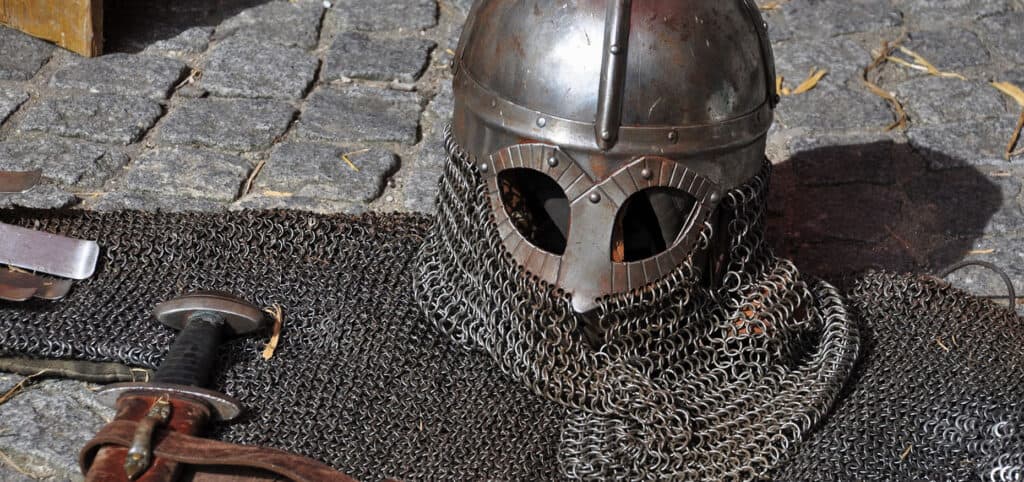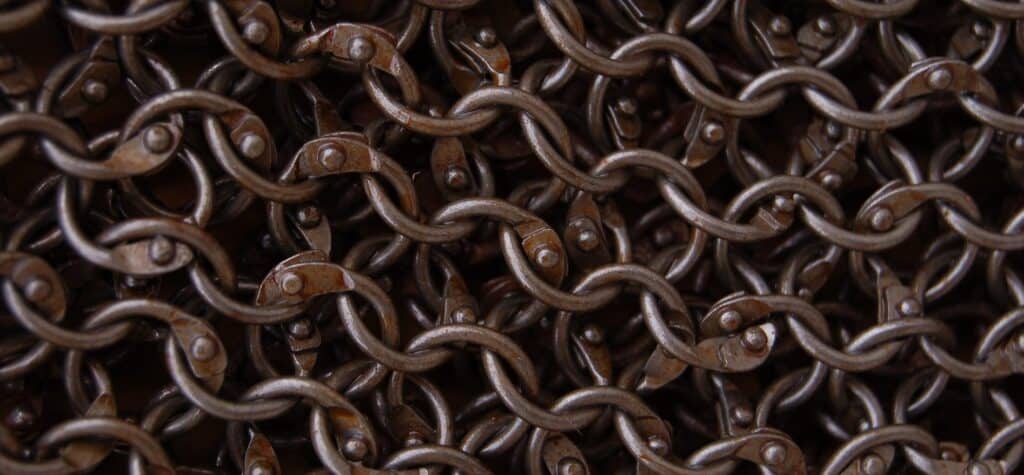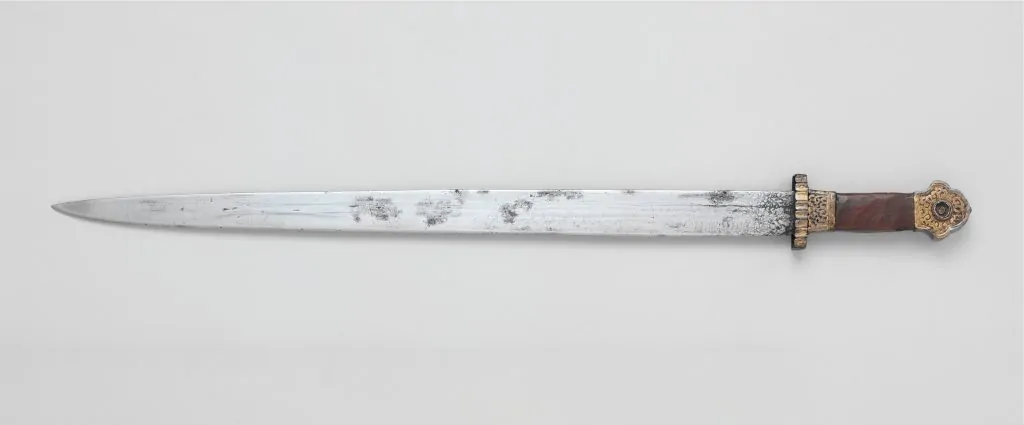
Chainmail and plate were the most popular armor sets through the Middle Ages. However, a lot of people don’t know the key differences between these armaments.
When comparing these two types only protection is considered, but there are a lot more aspects that we need to take a look at.
This article will settle the myths surrounding plate and chainmail once and for all.
Chainmail can’t be pierced by swords and axes. Plate armor on the other hand protects against all common medieval weapon types except the arquebus. Yet maille was used more commonly because it was cheaper and quicker to produce. The weight and the flexibility these armor types offer is identical. The choice boils down to wealth and the level of protection required.
Table of Contents
Plate and Mail Armor Comparison
This table highlights all the differences and similarities between mail and plate armor.
This table only takes into account the best type of each armor. That is riveted mail and custom-made plate armor forged from hardened steel.
A detailed discussion of every single property is appended thereafter.
| Mail Armor | Plate Armor | |
|---|---|---|
| Types | Riveted (best) Welded Butted | Hardened Steel (best) Soft Steel |
| Imperviousness | Impervious against swords, axes and some polearms | Impervious against all medieval weapons except arquebus. |
| Shock Absorption | None | Impact distributed across plate |
| Effect arming sword | Trauma | Slight Trauma |
| Effect longsword | Severe trauma | Trauma |
| Effect acute taper sword | Pierces | Slight trauma |
| Effect spear thrust | Pierces | Trauma |
| Effect polearm/axe | Pierces or severe trauma | Severe trauma |
| Effect bow | Pierces | Severe trauma |
| Weight | 15-25 kg (33–55 lbs) for full mail | 15-30 kg (33–66 lbs) for full plate |
| Comfort | Bad. Uneven weight distribution | Good. Weight equally distributed |
| Flexibility | Full | Full |
| Manufacturing | Easy but tedious. 100 days | Difficult but fast. 14 days |
| Price | 60 days’ wages of artisan | 60 days’ wages of artisan |
| Durability and Maintenance | High durability and easy repair | High durability but difficult repair |
| Other benefits | Can be concealed Good to march in Better ventilation |
Chainmail VS Plate Details
So now that we have a good overview, let’s take a deeper look at the various differences between plate and chainmail.
Types

There are three types of mail armor. That is riveted, butted and welded mail. The chosen linkage type makes a tremendous difference in protection.
Butted and welded mail can be penetrated by almost all weapons. On the other hand, riveted mail is of way higher quality and offers great protection against sword cuts, axe strikes and even some polearms.
Because the other two mail types are so inferior, we will only talk about riveted mail from now on.
In terms of plate armor types, I am not referring to the countless designs, but rather to the steel used.
For simplicity, we will categorize plate armor into soft steel and hardened steel.
Soft steel describes metal with a low carbon content that wasn’t tempered. On the other hand, hardened steel has a greater carbon content and was tempered, thus has a way higher hardness.
Munitions-grade (mass-produced) plate is far worse than its tailor-made counterpart (the difference is even greater than with the mail linkage types).
As the differences between plate armor are rather big, I want to clarify that I am referring to custom-made hardened steel plate armor in this post.
Imperviousness
Mail is highly resistant against swords, axes and some polearms. Other types of weapons like spears and bows can penetrate maille.
Plate armor offers optimal protection against every common medieval weapon type except gunpowder arms.
Swords, spears and bows aren’t able to pierce it. However, matchlock guns can penetrate plate.
But even if mail and plate can’t be pierce by some weapons that doesn’t mean that they cause no damage!
Next, we will talk about the shock-absorbing capabilities of plate and mail, followed by the effect of selected weapons on these armors.
Shock Absorption
In terms of shock absorption, plate armor is far better than mail armor. The rings of chainmail aren’t able to properly distribute the impact energy of a weapon.
For this reason, a longsword strike may already be enough to incapacitate a mail wearer, as the attack causes severe trauma and bone fractures.
On the other hand, plate armor excels at distributing attack energy across the entire steel plate, hence strongly reducing impact force and mitigating pain.
But even if plate armor is impervious and offers good shock-resistance the immense power produced by polearms or bows is still able to cause fractures and damage internal organs.
Moreover, the shape of plate armor facilitates the deflection of incoming attacks to further reduce the impact.
This isn’t the case with chainmail, because it adjusts to the body perfectly, thus creating flat and even surfaces.
Effects of specific weapons

Before we take a look at the protection level of these armor types I have to mention that the best way to defeat a mail or plate clad opponent is striking at areas that aren’t covered with armor (e.g. head or joints).
In that regard, swords are quite effective by employing techniques such as half-swording or mordhau.
An often-underestimated weapon is the dagger. Even though it deals no damage to either armor its accuracy and agility make it effective at stabbing unarmored body parts.
But now let us compare the effects of the following six medieval weapons on plate and mail armor.
Arming Sword
Cuts from this weapon don’t deal any substantial damage to targets wearing plate or mail armor. As discussed above plate is better at distributing the shock.
Longsword
Longswords are big, heavy and used with both hands. Therefore, the strike builds up more force.
An enemy soldier wearing only mail armor will suffer a lot of pain. However, a longsword slash isn’t able to pierce maille.
A knight covered in plate will feel less pain as it is mitigated by the shock resistance the armor type offers. Obviously, a longsword can’t penetrate plate.
Sword with acute taper
Swords with an acute taper are able to pierce maille. The estoc is a sword with a very acute taper and was specifically invented to pierce mail armor. Its point is so thin that it gets in-between the mail rings and splits them from the inside.
Plate armor can’t be pierced by the estoc. The thrust will cause a slight trauma, nonetheless.
Spear
A spear thrust pierces chainmail, but only bruises a plate wearer. The point of most spears fits inside the rings of the chainmail, therefore it can shatter them. A soldier wearing plate armor will suffer trauma and get some bruises by the spear thrust.
Polearm/Axe
A soldier wearing chainmail will experience a serious shock after a Dane axe strike.
Stronger weapons such as the glaive or pollaxe have a chance to break the rings of riveted mail by sheer force (even if it doesn’t pierce the defender will feel a lot of pain due to the force of the blow alone).
Plate armor can’t be penetrated by polearms and axes, but the strikes do lots of damage regardless. A way more powerful strike is required to incapacitate a plate wearer than a target clad in mail.
Bow/Crossbow
While these weapons certainly pack a punch and can puncture mail armor, a lot more force is needed to pierce plate.
A bodkin arrow requires 120 J of energy to pierce mail armor. A longbow with a draw weight of 140 lbs was able to generate roughly the required 120 J. So, without doubt mail can be penetrated by a strong bow.
Of course, a crossbow is even better. According to measures from Payne-Gallweya a siege crossbow with a draw weight of 1200 lbs can generate up to 200 J.
On the other hand, penetrating plate armor with a bodkin arrow requires 260 J of force (16th century Nürnberg infantry armor, keeled, 2.5 mm thick, shot at 45° angle).
Even though the crossbow bolt doesn’t penetrate plate armor its impact definitely causes internal damage (but isn’t lethal as would probably be the case with mail).
Sidenote: A bullet would require 1250 J to pierce plate. That is easily achievable with a regular arquebuse.
As this part of the post regarding projectile damage is rather controversial/unknown here is the source. (The Knight and the Blast Furnace by Alan Williams, pages 919, 943, 946-947)
Now we covered one more aspect of this topic and are closer to answering the plate vs chainmail question. Let’s move on.
Weight
Chainmail armor is heavy. A full set of mail weighs around 15 to 25 kg (33–55 lbs). A mail coat is called hauberk and weighs around 10 kg (22 lbs).
Mail leggings (chausses) have a mass of 5 kg (11 lbs). The coif (headpiece) adds another 2.5 kg (5.5 lbs). A pair of mittens or gauntlets weighs around 1 kg (2.2 lbs).
It is reasonable to expect a full set of chainmail to weigh 19 kg (41.9 lbs) on average.
Plate
A full set of plate armor weighs between 15 and 30 kg (33–66 lbs). The mass of plate armor suits differs strongly from set to set. Some armors were extremely light and others rather heavy.
The breastplate and backplate weigh around 3.5 kg (7.7 lbs) each. The helmet (e.g. burgonet) weighs 3 kg (6.6 lbs).
The tassets (upper-thigh cover) have a mass of 1 kg (2.2 lbs). Both cuisses and knee armor weigh 3 kg (6.6 lbs). To that comes the mass of the two greaves and sabatons of 3 kg (6.6 lbs).
The protection of arms and hands is another 5 kg (11 lbs). The gorget (throat protection) weighs roughly 1 kg (2.2 lbs).
Comfort
The wear comfort of mail armor is rather low. This is because its weight is unequally distributed.
When wearing mail armor most of the mass rests on the shoulders. This causes pain and fatigue if worn for a prolonged amount of time.
This effect is mitigated by the use of stomach belts. They transfer part of the weight to the waist thus increasing comfort, but still not completely solving the problem.
Custom-made plate armor is very comfortable because the weight is equally distributed across the body.
Munitions-grade plate armor on the other hand doesn’t fit the wearer perfectly and therefore has bad comfort.
Flexibility
The wearer of mail armor is completely flexible. No movements are hindered. Another benefit of mail is that it can cover all body parts, because of its small ring size.
Plate armor doesn’t decrease the range of movement. The wearer is still completely agile and no combat abilities are restricted.
An archer wearing a full set of plate would definitely have a hard time shooting his bow because of the gauntlets and pauldrons. (but this is only a theoretical limitation as archers mostly wore light armor)
Hence, mail and plate armor are on equal footing in terms of flexibility.
Manufacturing
A medieval craftsman required between 600 and 1000 hours to complete a mail hauberk. That means it takes him around 100 days to finish the product.
If we consider that such a knee-length mail shirt contains 25,000 to 50,000 individual links this timeframe makes a bit more sense.
The main manufacturing benefits of mail are that it can be produced easily and doesn’t require a skilled smith. So, mail shirts can be forged by apprentice armorers.
Plate
When forging plate armor accuracy is of utmost importance. Therefore, a skilled smith had to forge such armaments. Yet the production time was generally very short. In the middle ages it took around 14 days to forge a full set of plate armor.
Proper smithing and high-quality metal were vital when forging plate armor. Otherwise, weak spots would be created, due to areas with thinner metal or regions with a higher slag proportion.
Furthermore, setting up a smithy for plate armor requires a lot of capital as big furnaces are needed.
Price

Throughout the Middle Ages chainmail was cheaper than plate armor. Only at the end of this period the balance started to shift in favor of plate.
This change was caused by the rise of better manufacturing methods speeding up the process to forge plate armor.
It is really difficult to compare prices of these armor types, because there are very few sources and their quality was subject to big fluctuations.
The Ghent archives state that the price of a short mail tunic in the 14th century (1304) was around £ 15 Flemish (in the city Bruges).
At that time, a soldier earned on average three shillings a day. So, to buy a mail hauberk he would need to set aside 100 days’ wages.
That is a lot considering that the working year had roughly 240 days. (The Art of Warfare by Verbruggen, page 171)
Plate
The English soldier Sir John Cressy paid £ 6 for a complete Milanese plate armor which he purchased for his squires in 1441.
My main source assumes a daily wage of 1 s, therefore it amounts to 120 days’ wages. Yet my research concluded that the daily wage of a master artisan or soldier was around 0.5 s (6 d).
That would mean that a person needs to set aside 240 days’ wages in order to afford a high-quality full plate armor. (Wages and prices in England in the later Middle Ages by Schreiner, page 63 – The Knight and the Blast Furnace by Williams, pages 904, 907).
The prices of plate and maille in Iserlohn (Westphalia) offer a completely different perspective. In 1437 one suit of plate armor was 4.3 Rheinische Gulden each.
50 years earlier the price of mail shirts was 4.6 Gulden per piece in the same city. During that time the wage of an artisan was around 18 d.
Therefore, 57 and 61 days’ wages were required to pay for the respective armor. (The Knight and the Blast Furnace by Alan Williams, page 910 – Löhne und Preise von 1300 bis 2000 by Pies, page 18)
Here is a website that also contains prices of other goods
This website helps you convert Middle Age currencies
Durability and Maintenance
Chainmail has a very long lifetime compared to all other historic armor types. Furthermore, it was very easy to maintain and clean.
Another benefit is that broken rings can be replaced easily. It was even possible to do this in the field if you had some already punched rings, rivets, and a hammer with you. No furnace is required to link them together.
The durability of plate armor is very good. Cleaning it is straight forward. However, repairing the armament is tedious and requires expertise. To repair a pierced plate armor a furnace is needed as well (penetration could happen due to malfunction or production error).
Other benefits
With chainmail a person can also opt to conceal the armor simply by wearing another piece of clothing on top of it.
Mail armor also has the advantage that it is better to march in than plate. This isn’t necessary because of weight, flexibility or comfort, but rather due to the fact that chainmail offers superior ventilation.
Walking around in full plate armor during hot weather will get intolerable quite quickly. Maille is better suited in that regard (but is still far from perfect).
Conclusion
There are a lot of aspects where either mail or plate fares better. In the end, the choice of a soldier comes down to the specific situation, preference (and wealth).
A lot of people assume that the main advantage of mail is that it offers higher flexibility and is more comfortable. I hope this article showed that this certainly is NOT the case.
The benefits of mail include a lot of small advantages that most people don’t bother thinking about like ventilation and price.
Furthermore, the feudal system’s impact on the soldiers’ equipment shouldn’t be neglected. Logically, a noble who is forced to provide an army wants to save money and therefore goes with the cheapest choice possible.
Yet I need to admit that plate armor offers way better protection against attacks than mail (and this is the main function of armor).
However, underestimating the defensive capabilities of chainmail would be stupid.
Mail can’t be penetrated by swords and was extremely popular throughout history, so it definitely is one of the best (pre-modern) armor types even though it is inferior to plate.